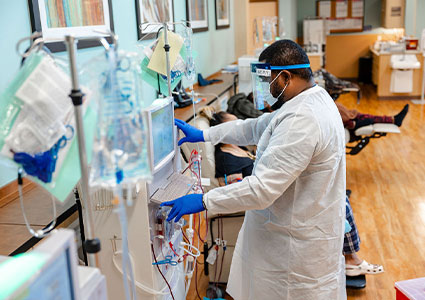
U.S. Renal Care’s tech-driven transformation is setting new standards for dialysis care
As the largest privately held and fastest-growing provider of in-center and home dialysis in the US, U.S. Renal Care (USRC) is committed to changing the lives of people living with kidney disease. With a team of experienced kidney health professionals, the organization partners with nephrologists to support more than 200 home programs and over 500 dialysis centers across 32 states.
Since its foundation in 2000, USRC has been a leader in clinical quality, innovation, and operational excellence, delivering the best experience and outcomes for the 36,000 patients under its care. Oscar Perez, Vice President of Supply Chain Operations, updates us on the company’s operations since we last spoke to USRC in 2022.
 “With numerous centers nationwide, we provide in-center and home dialysis options, as well as acute care services to hospitals,” he opens. “Our facilities ensure convenient access to high-quality care and assist patients with arranging dialysis during travel. Having grown by around 20 percent, our growth has been driven by a relentless focus on clinical and operational excellence, as well as our keen focus on our relationships with our physician partners. We’ve developed tools to optimize schedules and team member assignments, and we’ve also implemented a more efficient patient referral process.
“With numerous centers nationwide, we provide in-center and home dialysis options, as well as acute care services to hospitals,” he opens. “Our facilities ensure convenient access to high-quality care and assist patients with arranging dialysis during travel. Having grown by around 20 percent, our growth has been driven by a relentless focus on clinical and operational excellence, as well as our keen focus on our relationships with our physician partners. We’ve developed tools to optimize schedules and team member assignments, and we’ve also implemented a more efficient patient referral process.
“From a supply chain perspective, our transformation journey has strengthened the trust our leadership has in us; our supply chain has become an enabler of organic and inorganic growth for USRC. As you may recall from Janet Watson’s interview with Supply Chain World two years ago, our supply chain model consists of a value-capture strategic arm focused on sourcing, category management, contracting, value-creation, and an operations execution arm.
“The transformation of our supply chain operational processes and tools ensures a tight link between the value we negotiate and the execution of our contracts. For example, we have optimized the use of standard supplies like dialyzers, acid concentrate, and bloodlines by 20 percent via outlier-spend dashboards that correlate usage with patient orders.
“We also began providing administrative services to Satellite Healthcare in 2023, and our scalable supply chain processes enabled a smooth integration of clinics,” Oscar adds. “We apply the same rigor of supply chain excellence to their operations to ensure both of our organizations have exceptional processes for sourcing, contracting, inventory management, and purchasing.”
Prioritizing patients
In 2023, USRC’s clinical team initiated an anemia management medication policy conversion, a critical component of dialysis treatments. “Our supply chain team effectively managed inventory levels, ensuring no missed administrations, minimizing emergency orders, reducing waste, and optimizing value from the new medication from day one,” Oscar elaborates. “We monitored utilization and spending into the second quarter of 2024, ensuring expected patient outcomes and stable inventory levels. We combined supply chain analytics, EMR data, and improved processes that resulted in 70 percent inventory reduction prior to conversion and 95 percent reduction in waste when compared to prior conversion practices.”
Alongside growth, USRC consistently prioritizes patient care. “Ensuring our patients receive the highest-quality patient care is at the center of everything we do,” Oscar states. “We use prescriptive visualization dashboards to manage usage outliers and provide transparency to our clinicians of their supply usage, waste, and opportunity. We partner with our medical office, IT, clinical services, accounting departments, and our suppliers to ensure smooth operations at every level of our business.”
Contributing to USRC’s highly efficient supply chain are a range of technologies designed to optimize operations. “We utilize mature ERP tools and design other procurement tools in-house, leveraging our team’s diverse experience from industries such as energy, telecommunications, defense manufacturing, and healthcare,” Oscar explains. “By applying advanced analytics and modern visualization tools, we maximize the use of these systems. We’ve also adopted structured issue resolution and management tools, converting substantial amounts of disparate data into cohesive information for proactive process improvement.
procurement tools in-house, leveraging our team’s diverse experience from industries such as energy, telecommunications, defense manufacturing, and healthcare,” Oscar explains. “By applying advanced analytics and modern visualization tools, we maximize the use of these systems. We’ve also adopted structured issue resolution and management tools, converting substantial amounts of disparate data into cohesive information for proactive process improvement.
“We’re also currently modernizing our ERP, procurement, and inventory management tools. Our transformation so far has yielded significant savings and optimized cash flow, giving us the confidence to pursue further improvements with modern tools and processes.
“As part of our transformation, we partner with suppliers who share our vision for analytics and data-driven supply distribution management,” he continues. “We have weekly reviews to quickly react to disruptions, create backorder plans, review invoice price discrepancies, and monitor KPIs such as re-route incidence, credits incidence, and issue resolution ticket incidence. For example, our ‘complete-PO-shipped’ performance improved from under 50 percent to close to 90 percent, which enabled our field-based inventory management resources to further optimize labor by as much as 20 percent. This ensures stable and predictable supplier performance, allowing us more time to monitor market dynamics and other strategic opportunities.”
Continued evolution
Oscar then turns his attention to USRC’s ongoing transformation and how it positions the company for a successful future. “We’re currently navigating new legislation from the Centers for Medicare and Medicaid Services (CMS), including the addition of certain medications to the dialysis treatment bundle and the approval of additional drugs for the Transitional Drug Add-on Payment Adjustment (TDAPA),” he says. “These changes present significant opportunities for us to improve our patients’ access to innovative therapeutics. Our supply chain team, emboldened by our proven execution excellence, and in partnership with clinical teams, is executing change programs to make these therapies available to our patients.
“Looking ahead, I envision USRC incorporating new AI tools to enhance the supply chain services we provide to our internal customers and foster increased collaboration with our suppliers,” Oscar concludes. “AI will play a crucial role in self-serve automation for clinics, real-time adjustment of inventory management parameters, and a faster approach to disruption preparation and management in the upstream supply chain.”